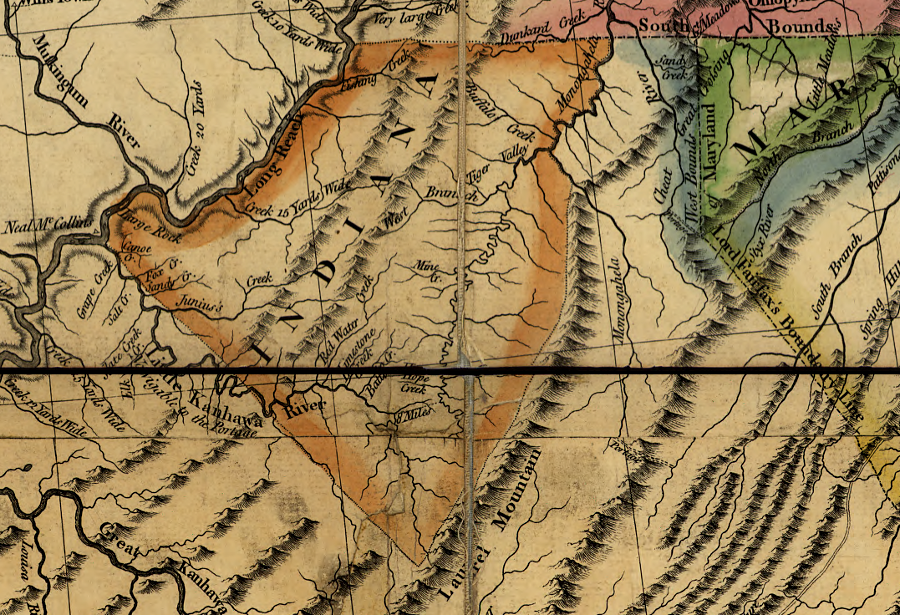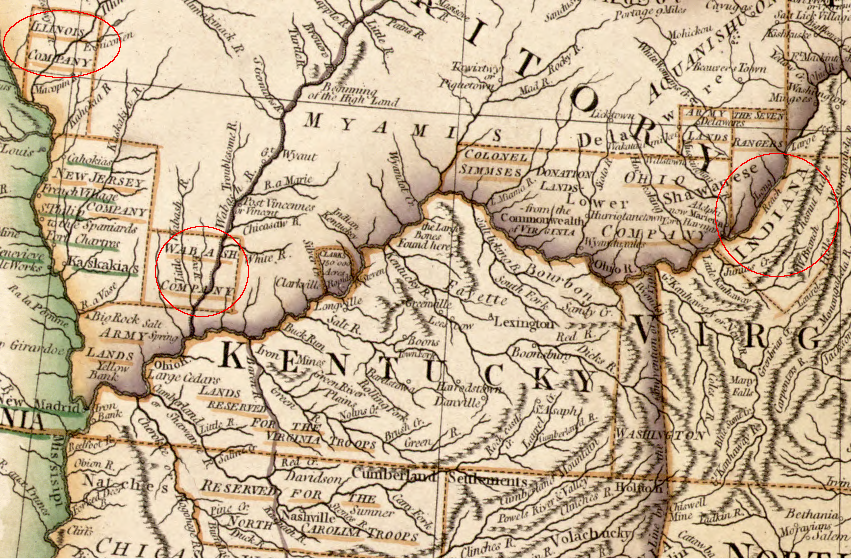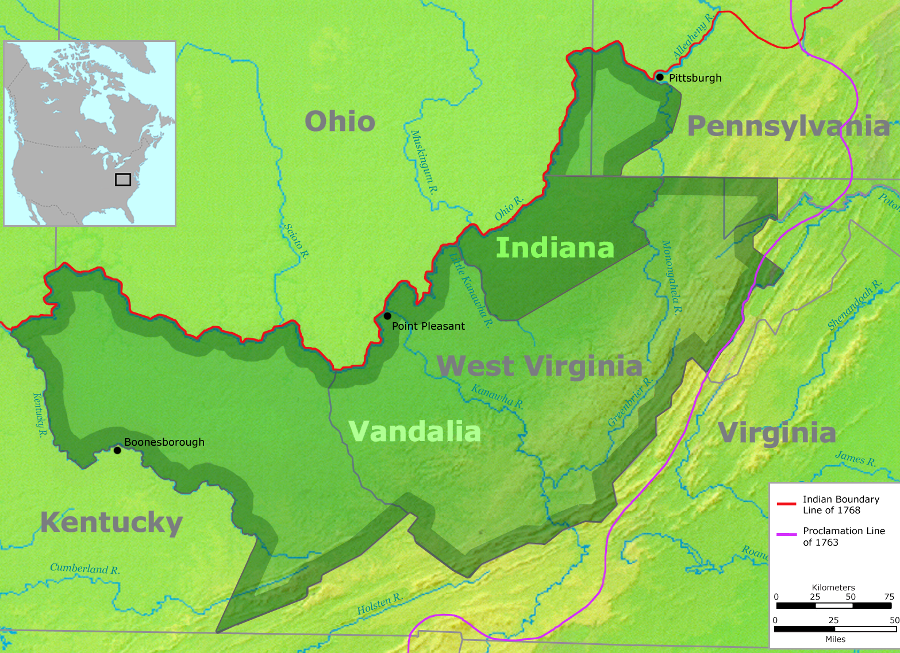Vandalia and the Grand Ohio Company

the "suffering traders" affected by Pontiac's War obtained the Indiana Grant as compensation
Source: Library of Congress, A new map of the western parts of Virginia, Pennsylvania, Maryland, and North Carolina; comprehending the River Ohio, and all the rivers, which fall into it (Hutchins, Thomas, 1778)
The French and Indian War blocked the Ohio Company, Greenbrier Company, and Loyal Land Company from selling parcels from their grants in the Ohio River watershed. Pontiac's War in 1763 further delayed occupation of the lands west of the Allegheny Front.
Philadelphia-based land speculators still sought to obtain a massive land grant in the lands along the Ohio River. The Wharton family and others formed the Illinois Company and requested a 1,400,000 land grant, but failed to get any official support after George III issued the Proclamation of 1763.
The investors then sought a new justification for a land grant, and acquired the claims of the "suffering traders." At the start of the French and Indian War, Native Americans and their French allies had seized the goods shipped by various colonial traders to backcountry locations to exchange for furs. More goods had been lost at the start of Pontiac's War almost a decade later.
The British government owed nothing to these traders or their financial backers; they had sought high profits by taking high risks, and suffered a business loss. The land speculators saw an opportunity aligned with the traders, and formed the Indiana Company. They then sought to get compensation from the Native Americans though the negotiations that led to the 1768 Treaty of Fort Stanwix.

the Indiana company sought to acquire land near Fort Pitt, while the Wabash and Illinois claims were located far to the west
Source: Library of Congress, The United States of North America, with the British territories (William Faden, 1793)
Sir William Johnson was the Superintendent for Indian Affairs, Northern Department, and led the negotiations. He was not a member of the Indiana Company, but his support for altering the boundary defined in the Proclamation of 1763 was essential. If the boundary had remained the Eastern Continental Divide, there would be no value for the Indiana Company in obtaining rights to lands in the Ohio River valley.
The Iroquois negotiated terms for the Shawnee, Delaware and others who occupied the Ohio Country, and agreed to give a chunk of land ("Indiana") as compensation to the suffering traders. Indiana was located south of the Ohio River, and stretched east to the Monongahela River.
The tactic of getting land rights in the 1768 treaty negotiations reflected the fixed location of Pennsylvania's boundaries. Though the colony's western edge was still undefined at the time (it was not settled until 1784), everyone knew hat Penn's grant limited the width of his colony to five degrees of longitude. Unlike Virginia, Pennsylvania did not have western land claims extending to the Mississippi River. Colonial officials in Philadelphia had fewer options for rewarding influential land speculators than colonial officials in Williamsburg.
The Virginia colony's land claims along the Ohio River dated back to the Second Charter issued by King James I in 1609 to the Virginia Company, and Virginia refused to relinquish its claim to the Indiana lands. The representatives of the suffering traders, Samuel Wharton and William Trent, went to London in 1769 to seek a royal approval that would bypass any title asserted by officials in Williamsburg.
Benjamin Franklin, Pennsylvania's land agent (lobbyist) in London, joined the effort to confirm the Indiana claim negotiated with the Iroquois. Franklin, Wharton, and Trent conspired to expand the scope of their efforts and seek a land grant even larger than what the Iroquois granted, and larger than the original dreams of the Illinois Company.
They partnered with Thomas Walpole to gain greater influence at court. Walpole was the nephew of Sir Robert Walpole, who had established the role of Prime Minister in Great Britain. They formed the Grand Ohio Company (also called the Walpole Company). In the process they reduced the expected benefits to some of the original colonial claimants to the Indiana grant, but still offered them a chance to gain something. Even the Ohio Company claimants, losing hope that their 1749 grant for up to 500,000 acres in the Ohio River Valley would be honored, agreed to join the Grand Ohio Company for a small percentage of what the English called the proposed Walpole Grant.
The new objective was to get a charter for a new colony totaling 2,000,000 acres. They considered naming it after William Pitt, but chose the name Vandalia. That honored the German heritage of King George and his wife Charlotte, supposedly descended from the Vandals.1

the "sufffering traders" obtained the Indiana Grant as compensation in the 1768 Treaty of Fort Stanwix, and land speculators expanded it to the proposed two-million acre colony of Vandalia
Source: Wikipedia, Ohio Company
The Privy Council gave preliminary approved to the creation of the Vandalia Colony in 1773. Samuel Wharton anticipated being appointed governor and living at Fort Pitt.
However, The plans for formalizing Vandalia faded as British officials focused on American rebelliousness in 1774-1775. The slow legal process to finalize the creation of Vandalia was never completed.
Virginia took control of Fort Pitt and awarded its own land grants in the disputed territory. In 1774 Lord Dunmore himself came to Fort Pitt, in command of part of an army that forced the Shawnee to sign away their land claims in the Treaty of Camp Charlotte.2
Thomas Wharton sought to revive the Indiana Company in 1776, but conflicts between previous investors blocked any action. In the 1780's, Samuel Wharton used his position in the Continental Congress to seek some sort of land grant based on the claims of the suffering traders, but Virginia negotiated its cession of the Northwest Territory so the state maintained its control over lands south of the Ohio River.
In the end, the suffering traders who sold their claims early were the only ones to benefit. Investors in the Indiana Company, Illinois Company, Grand Ohio Company, and Vandalia Colony sold no land and received no profits.3
In 1863, the western counties of Virginia created a new state separate from the Restored Government of Virginia. One name proposed for the new state was Vandalia, before final adoption of the name West Virginia.4
Links
References
1. Barbara Rasmussen, Absentee Landowning and Exploitation in West Virginia, 1760-1920, University Press of Kentucky, 2015, pp.24-26, https://books.google.com/books?id=CK4eBgAAQBAJ; "Vandalia: The First West Virginia?," West Virginia History, West Virginia Archives and History, Volume 40, Number 4 (Summer 1979), http://www.wvculture.org/HISTORY/journal_wvh/wvh40-4.html (last checked August 16, 2016)
2. "Affairs In Virginia; The Indian Expedition," Lord Dunmore'a official report to the Secretary of State Lord Dartmouth, December 24, 1774, in Reuben Gold Thwaites, Documentary history of Dunmore's war, 1774 , Wisconsin Historical Society, 1905, p.370, https://archive.org/details/documentaryhist00thwarich (last checked August 18, 2016)
3. "Vandalia: The First West Virginia?," West Virginia History, West Virginia Archives and History, Volume 40, Number 4 (Summer 1979), http://www.wvculture.org/HISTORY/journal_wvh/wvh40-4.html (last checked August 16, 2016)
4. "What's in a name? The origin of 'West Virginia'... and what the state might have been called instead," West Virginia Tourism Offce, https://wvtourism.com/whats-name-origin-west-virginia-state-might-called-instead/ (last checked June 22, 2019)
Exploring Land, Settling Frontiers
Virginia Places


